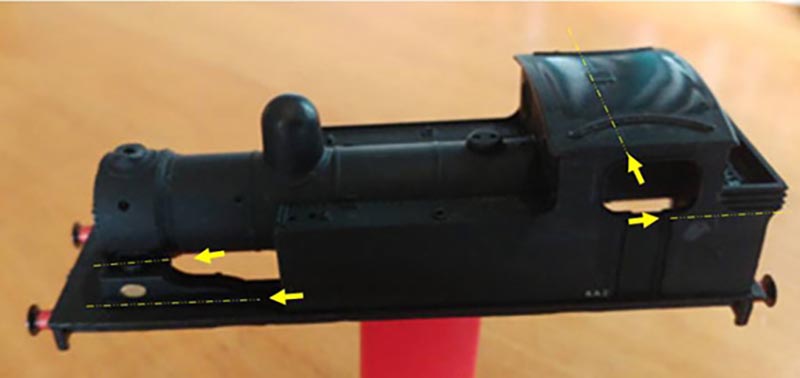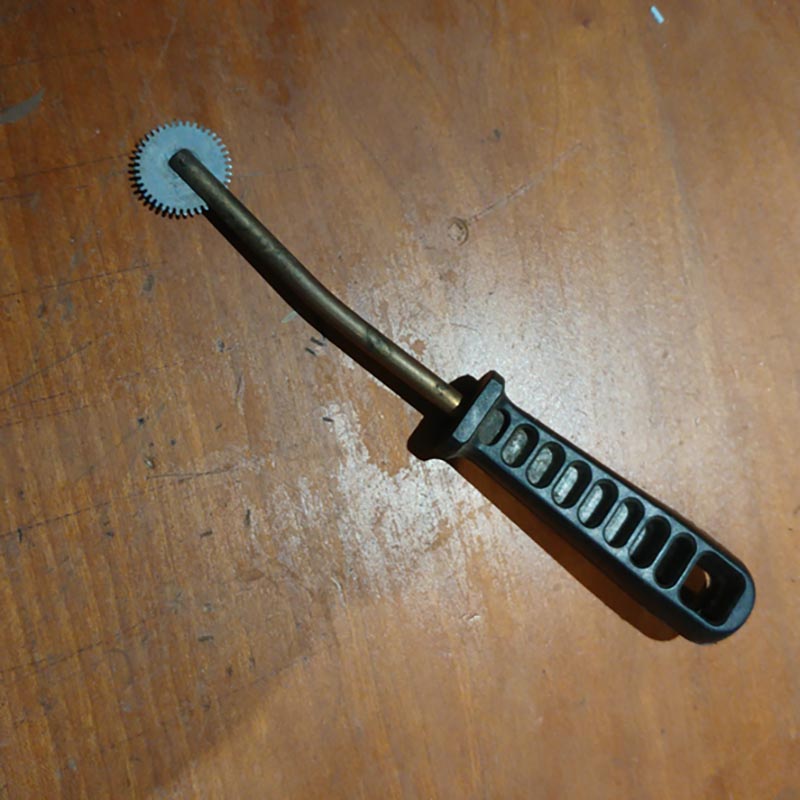Andrew’s been back in touch with a wonderful kit bash ‘how to’ – it’s very much like making your own custom model trains.
Embarrassingly, this was sent in ages ago. I discovered it clearing down my emails this week.
“Mommy says I am a hoarder but prefer the term “Collection Connoisseur”, after all, you never know when that little oddity will come in useful.
Besides it lends itself to my objective of “modelling on a shoe string”.
In my opinion, one of the cutest (if one can use such a term when describing railwayania) is the Midland Railway Class 1F (0-6-0T).
I know that there are some fine models out there but where is the fun in that, besides I have been looking for a locomotive to model where I can experiment on a new, low cost method of producing a chassis. So, let’s get on with it.
Scratching through my “hoard”, I came across a Mainline J72 body that had lost its chimney and on comparing it to the drawing, I thought that with a small amount of cutting and filing and hacking,
I could transform that into a reasonable facsimile of a Class 1F.
Fortunately for this article, the body was black and Plasticard is white so I think that without too much explanation, the pictures will tell the story.
Using my trusty no 10 scalpel (with that box of Band-aids close at hand), I cut away the front wheel arches and sand boxes and made up new splashers and filler sections.
A portion of the footplate where the sand boxes were was glued in place to cover the resultant gaps. Tamiya putty would as always hide a multitude of sins.
I had set my mind on the early open cab format so I sliced through the roof and reshaped the “windows”.
Obviously, I lost the rear wall between the cab and the coal bunker in the process but was careful to keep as much of the coal as possible, installing a new “wall” to stop the coal from falling out.
Next I cut thin strips of 0.5mm thick Plasticard into lengths and glued them in place to form the ridges around the tanks. Strips of 1mm thick Plasticard was fitted around the coal bunker in similar fashion. The tricky part was the lining around the “windows”where in the same manner 0.3mm Plasticard strips were applied. Once dry, these were sanded with 800grit water paper to ensure that they were smooth and straight.
You probably noticed in the first picture that the body had no steps and these were done last as they tend to break off with too much handling. Once again, 0.5mm Plasticard was used for the legs and 3x3mm Plastruct angle was trimmed to size and glued in place for the steps.
The broken off chimney remains were filed away in order to obtain a smooth rounding. You may find here that the file will slip and the rivets around the smoke box are destroyed in the process. Never mind this is easy to fix with a handy little homemade tool and I digress briefly so that you can make one of your own.
The Rivet Tool: Talk to your local watch-maker/jeweller and request a clock’s brass gear, as fine as possible and approximately 30mm in diameter (I’m sure you must have one lying around from one of your wind-up toys).
Now take a piece of 6mm round brass and drill a 2 or 3mm hole through the centre about 6mm back from the end. Cut a groove wide enough to insert the gear and approximately 30 in from the end. Give a slight bend to the bar (about 15°) approximately 100mm from the cut end.
Insert the gear into the slot and fix in place using a small bolt and nyloc nut. Push the other end into an old file handle and you are done. I would suggest that you round the gear teeth slightly so that there are not too many sharp edges.
So, how now? Well, cut a strip of 0.25mm Plasticard to the same width as the length of your smoke box. Place the Plasticard onto a firm (not hard) surface (a piece of softish timber will do the trick), place a steel straight edge onto the plasticard, approximately 0.5mm from the edge.
Now run the gear of your rivet tool down the length of the Plasticard applying enough pressure to make an indentation without going right through the Plasticard. Repeat on the other side. Next, turn the Plasticard strip over and laminate this to your now smooth smoke box. Hold in place with a clothes peg or other suitable item. You have now repaired the rivets on your smokebox and any mistakes can be hidden with some paint.
Now, back to the subject at hand.
Fill in all the handrail holes with Tamiya putty and once dry, sand smooth finishing with 1200 grit paper. So that is the bodywork pretty much done. Carefully wash with warm soapy water, rinse well with clean water and leave overnight under a cover (like a clean, empty ice cream container) in order to dry.
Avoid touching the body with bare hands as you may well leave an invisible oily residue which once painted, will make you look like a trainee copper taking fingerprints at a crime scene. I use cheap latex gloves for handling at this stage and find that when spraying, keeping them on makes sure the hands are clean.
I stripped off all the loose bits putting them one side for later use and held the body up against a 1:1 scale drawing which in this case was a photograph which I scaled using Adobe Photoshop®. It all looked good so far.
Overspray the entire body with a gloss black and put one side to dry. Once again, the trusty ice cream container comes in useful. I normally resist the urge to mess with it for 2 to 3 days to be sure that the paint dries well. It is important that the paint bonds properly and you may well opt to use a plastic primer before you apply colour. Extending the process byanother 2 to 3 days is well worth the wait.
Scratching about in my junk box, I found a suitable white metal chimney and although not 100%, it looked good enough. A hole was drilled and it was fixed in place with a dab of super glue after first filing away a small amount of the paint so that it bonded.
It is now time to tape up and apply that wonderful Midland Red that makes all their locomotives such an attractive sight to see. Having handled the painted body quite a bit, it received another wash with warm soapy water, rinsed and dried as previously.
With careful reference to as many photographs and pictures as I could find, I taped up all the areas that should remain black.
This entailed cutting thin strips of masking tape on a CLEAN glass surface and carefully applying as required.
I left the smokebox and chimney uncovered as they would require a satin black finish.
The exact choice of red is up to you but I used what I had and am quite happy with the endresult. Don’t be in too much of a hurry to peel off the masking tape, rather leave it to dry properly.
Now apply the decals as per Midland specifications and you are done for all intents and purposes.
The picture below displays my almost final product.
Taking it a step further, I wanted to hide the motor so I decided to fabricate the boiler detail inside the cab.
A bit of extra effort but worth it at the end of the day.
Using bits of scrap, cut and trimmed bits and pieces to produce a not very accurate but reasonable impression. I am not going to go into the detail of this as I think it is fairly obvious from the picture.
You can of course purchase a white metal or plastic option from your local hobby shop but we don’t have that kind of facility here. What I did notice from the few pictures I was able to find on the Internet was that this was predominantly brass with the inside of the cab being white.
Now to find some hand rails and some valves of the right design and I am done!
Currently, I am experimenting with the manufacture of a chassis using etched PCB and 10mm brass and once this is completed and tested, I will follow up with Part 2 on how to make the chassis in this manner.
I hope this provides further inspiration for producing acceptable models on a shoe-string budget.
Andrew”
A huge thank you to Andrew – loved what he’s done. Very clever and very frugal.
I suspect kit bashing is alot cheaper and alot more fun that buying custom model trains.
Now on to Alan.
He’s a man of few words, well none, but he sent in this which I thought was rather good:
That’s all for today folks.
Thanks to Andrew and Alan.
Please do keep ’em coming, I really am running out of stuff!
And if today’s the day you start your layout, the Beginner’s Guide is here.
Best
Al
PS Latest ebay cheat sheet is here.












I, m70 years old I just got rid of my HO set two weeks ago. I fell in love with the already made Coffee Table train set in N gauge on E-Bay I,m a musician and song writer the last few years and I got a real good handle on my music now. I LIVE IN A CONDO , no room now and still miss electric trains. I,m hoping and still looking for the one that sold in a day a few weeks ago for a few hundred on E,bay I fell in love with it but i sold the next day! I live i New York and I,m traveling to Mid Florida in a couple of weeks still looking online. If you know anyone selling that type on set Coffe Tablel Train set Please notify me. If it under 50 miles or so I can pick it up. Rich Davis, Thanks
A good Demo on how to Andrew…well done
Good workmanship.!!!!!.
Now there is an example of model railroading. Excellent work. Probably over thirty years ago I ran across a “sweep” that I did not know existed. We had General motors “Geeps” or a GP series of engines and we had switcher engines that were designated SW-7 that has square bodies. The “sweep” had a GP-7 body and a cab but the end was cut off. I’d send a photo but in this format I can’t. I bought a new GP-7 model and a sw-7 model and cut and joined them to make a model sweep. My model is shown in some of my videos about trains on YouTube.
Beautiful work.
Very nice modeling.
Way too much work for me, plus I wouldn’t have enough band aids. Great work though.
If you don’t want to make one of those tools for yourself, go to the sewing section of the craft store. They make a tracing wheel that looks exactly like that. It is used for tracing details from sewing patterns onto fabric using coated paper in between. I have several of these!